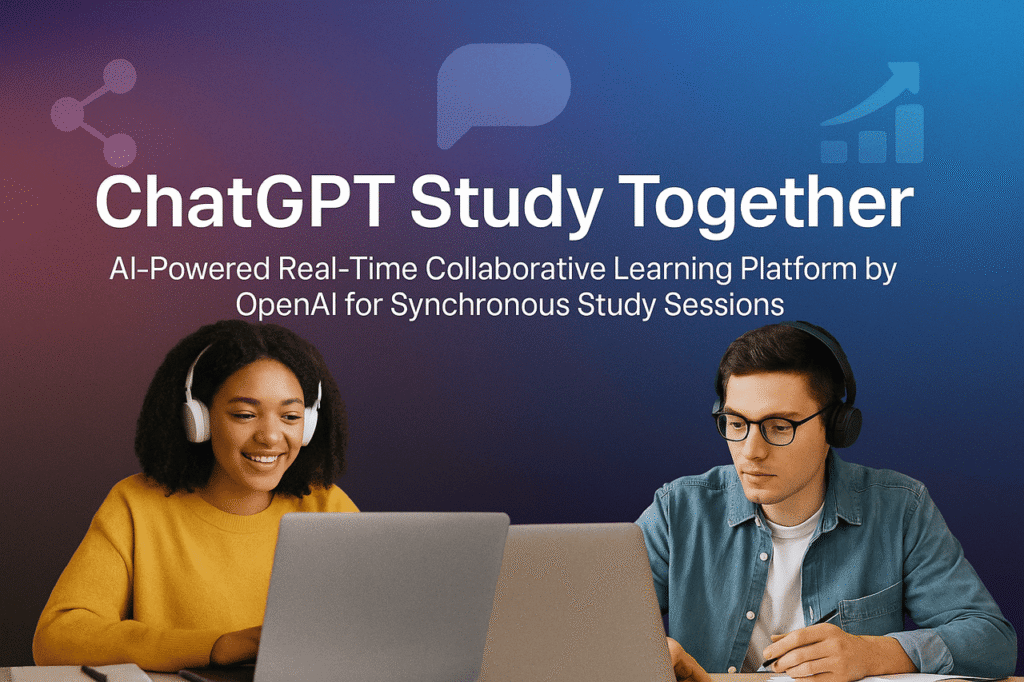What is the ‘Study Together’ feature in ChatGPT?
The ‘Study Together’ feature in ChatGPT is a newly introduced, collaborative AI-assisted learning environment that enables multiple users to engage in synchronized study sessions. This experimental tool blends real-time interaction, shared virtual study spaces, and context-aware AI tutoring into a singular user experience. The feature leverages the underlying GPT model’s multi-user context retention and conversational memory to dynamically adapt to different users’ study needs within a shared session.
By structuring the interaction like a group study, the feature enhances learning through peer accountability, shared goal tracking, and live problem-solving all under the guidance of a single or multiple ChatGPT instances. Users can ask questions, annotate responses, and track collective or individual progress.
How does ‘Study Together’ transform collaborative learning environments?
Multi-User Session Integration
Multiple users can join a single session where AI provides synchronized contextual replies based on a unified chat history. Each participant’s query is considered part of a larger discourse thread, allowing the AI to recognize evolving topics and respond with refined relevance.
Shared Intent Tracking
The feature maps individual learning goals (Entity: User Goal, Attribute: Topic Mastery, Value: Linear Algebra or Poetry Analysis) and aligns them across the session. The AI adjusts its guidance based on overlapping or diverging user intents using embedded NLP intent parsing.
Session Memory and Continuity
Study progress is tracked across sessions. Semantic memory stores user-specific queries, preferred study formats, and recurring gaps in knowledge. When users rejoin, the AI references prior learning states, making each session cumulative and personalized.
Synchronous AI Interaction for Group Tasks
AI supports group projects by parsing group-generated content and returning synthesized summaries, cross-verified answers, and contradiction alerts. The feature detects when users provide conflicting inputs and offers reconciliation strategies using logical entity extraction.
Dynamic Role Assignment
AI assigns implicit roles based on user behavior leader, researcher, explainer allowing for structured participation. This approach fosters collaborative agency, ensuring all users contribute to the learning process while the AI tailors its responses based on perceived roles.
Who benefits most from the ‘Study Together’ functionality?
Students in Remote or Hybrid Learning
The feature creates a virtual academic co-presence, allowing learners in different locations to engage in real-time collaboration. By emulating organic study group dynamics, it reduces cognitive isolation and enhances peer motivation.
Educators and Mentors
Teachers can use the feature to guide groups, assign problem sets, and monitor student engagement. With session transcripts and AI insights, educators can extract learning analytics and identify where intervention is needed.
Self-Learners Seeking Accountability
Independent learners gain structure through time-boxed collaborative sessions. AI-driven goal setting and periodic nudges ensure consistency and minimize procrastination in long-term projects or certifications.
Professional Development Cohorts
Organizations running internal upskilling programs can use ‘Study Together’ for teams to co-learn. Shared AI responses foster unified comprehension, especially in technical topics like cloud computing or data ethics.
Language Learners and Writing Groups
By enabling collaborative story-building, grammar correction, and vocabulary drills, the feature fosters immersive, peer-supported language acquisition experiences, complete with AI-mediated grammar disambiguation and cultural context mapping.
How does the feature reflect the future direction of AI in education?
Scalable Human-AI Co-Learning
‘Study Together’ represents a scalable co-learning model, where AI no longer serves just as a solo tutor but becomes a facilitator of human-to-human + human-to-AI interactions. AI shifts from being a passive tool to an active participant in collaborative knowledge construction.
Personalized Group Intelligence
The system intelligently balances individual personalization with group coherence, creating a hybrid learning network. This dual-layered intelligence aligns with the pedagogical principles of social constructivism.
Disintermediation of Traditional Platforms
By embedding collaboration within ChatGPT’s core interface, the feature bypasses the need for third-party study apps, integrating note-taking, tutoring, and group chat in one interface. This shift supports seamless multi-modal learning environments.
Dynamic Knowledge Graph Creation
Every session contributes to a semantic learning graph, tracking nodes (concepts) and edges (interactions), which could be visualized for users. Over time, learners receive insight into their knowledge evolution and study trajectories.
Ethical Implications and Privacy Concerns
As collaborative AI grows, so does the need for privacy-respecting session logs, consent for knowledge sharing, and differentiated access levels (e.g., who sees what). The ‘Study Together’ beta hints at OpenAI’s potential movement toward regulated, ethical group-AI collaboration.
Stay ahead with breaking tech news, AI breakthroughs, and digital trends by exploring our full News & Technology insights library.

